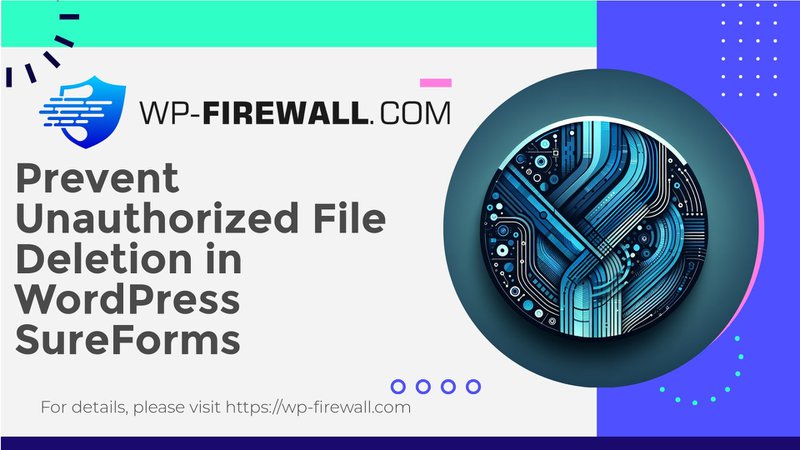
Summary
A critical unauthenticated arbitrary file deletion vulnerability (CVE-2025-6691) affects the SureForms WordPress plugin up to version 1.7.3. Attackers can exploit insufficient authentication and input sanitization to delete any file on a vulnerable site, risking breakdown, data loss, and further compromise. This flaw has been assigned a CVSS 8.1 (High) severity rating. Immediate patching to version 1.7.4 or later is essential, along with auditing for deletion, virtual patching via WAF, and long-term security hygiene.
In-Depth Vulnerability Details
| Plugin | SureForms |
|---|---|
| Versions | ≤ 1.7.3 |
| CVE | CVE-2025-6691 |
| Date | 2025-07-09 |
| Urgency | High |
| Type | Unauthorized Access / Privilege Escalation |
| Impact | Unauthenticated attackers can perform arbitrary file deletions, including core files, plugin files, uploads, and configuration files, leading to site breakage, data loss, and further exploitation. |
Critical Alert: Unauthenticated Arbitrary File Deletion Vulnerability in SureForms Plugin (≤ 1.7.3)
As WordPress security experts deeply focused on keeping your websites safe, we want to bring urgent attention to a severe vulnerability recently discovered in the widely used SureForms plugin version 1.7.3 and earlier. This flaw allows unauthenticated attackers to perform arbitrary file deletion on your WordPress site — a highly dangerous security gap that demands immediate action.
Understanding the Vulnerability: Arbitrary File Deletion Exposed
The SureForms plugin enables WordPress users to easily create drag-and-drop forms, making it popular among site owners seeking convenience and flexibility. Unfortunately, versions 1.7.3 and earlier of SureForms harbor a security defect that can be exploited without any user authentication.
What Does Arbitrary File Deletion Mean?
At its core, arbitrary file deletion lets attackers delete any files located within your WordPress environment — including critical core files, plugin files, uploaded content, or configuration files. When core files are deleted or altered, your website may:
- Become partially or entirely broken
- Lose critical functionality
- Expose sensitive data
- Be vulnerable to further exploitation
The potential for irreparable damage and downtime is significant, especially when attackers automate such exploits to compromise hundreds or thousands of websites.
Technical Breakdown: How Can This Happen Without Login?
This vulnerability stems from insecure handling of administrator submission deletion within the SureForms plugin. Due to improper validation and missing permission checks, attackers can craft specific requests that instruct the plugin to delete arbitrary files.
Key technical points include:
- Lack of authentication checks: Attackers do not need to log in or have any privileges to trigger the deletion process.
- Insufficient input sanitization: Unsuitable filtering on file paths allows directory traversal or targeting of unintended files.
- Exploitation vector: Crafted HTTP requests can abuse plugin endpoints intended for legitimate form management.
This kind of vulnerability falls under OWASP’s A3: Injection category, as malicious inputs lead directly to destructive file operations.
Severity Analysis: Why This Qualifies as a High-Priority Threat
Security professionals have scored this vulnerability with a CVSS score of 8.1 (High Severity), underlining the urgency and risk level for affected websites.
Key risk factors:
- Unauthenticated access: No user credentials required, so attackers can abuse it from anywhere.
- Wide impact surface: Millions of WordPress installations use SureForms, exposing countless sites.
- Potential for mass exploitation: Once publicized, vulnerability scanners and mass exploit kits rapidly target such holes.
- Destructive impact: Full or partial site breakdown common after successful file deletion attacks.
If exploited at scale, this vulnerability could cripple websites, cause data loss, and incur heavy recovery costs.
Who Should Be Concerned?
- Website administrators running any version of SureForms up to and including 1.7.3.
- Agencies maintaining client sites with SureForms installed.
- Managed WordPress hosting providers with SureForms users in their network.
- Security professionals monitoring WordPress plugin vulnerabilities.
Even if SureForms is not actively used on your site, it’s important to identify and remediate vulnerable installations. Attackers constantly scan for any exposed endpoints to exploit.
Immediate Remediation Steps: How To Protect Your Site Right Now
1. Update to SureForms Plugin Version 1.7.4 or Later
The plugin developer has addressed this vulnerability in release 1.7.4, which implements proper authentication checks and sanitization to block unauthorized file deletions. Upgrading to this version is the single most important step you can take.
- Go to your WordPress dashboard → Plugins → Installed Plugins.
- Locate SureForms and update it to the latest version.
- If automatic updates are enabled, verify that the plugin has successfully updated.
2. Audit & Restore Deleted Files
If you suspect exploitation:
- Check your site for missing or altered files.
- Restore affected files from backups.
- Verify file integrity using checksums or security plugins.
3. Harden Your Site Further
Even after patching, consider reinforcing your site’s defenses:
- Implement Web Application Firewall (WAF) to block suspicious HTTP requests before they reach WordPress.
- Limit file permissions on your server to prevent unauthorized deletions.
- Use monitoring tools to detect file changes in real-time.
Why Waiting to Patch Can Be Catastrophic
Attackers automate scanning and exploitation of vulnerabilities soon after disclosure. Delaying plugin updates not only leaves your website vulnerable but effectively hands over full control to malicious actors. They don’t discriminate — every site with the vulnerable plugin is a possible target.
Moreover, given that the exploit requires no authentication, the likelihood of widespread, automated attacks skyrockets. History shows that vulnerabilities like this can result in mass website defacements, ransomware deployments, or permanent data loss.
Virtual Patching and Continuous Protection Strategy
Beyond patching SureForms directly, sites can benefit from virtual patching mechanisms. Virtual patching intercepts dangerous HTTP requests targeting known vulnerabilities at the firewall level, providing instant protection even before plugin developers release official fixes.
Such an approach complements your plugin updates by adding an additional security layer, helping to:
- Prevent zero-day exploits
- Block exploitation attempts in real-time
- Reduce risk during patch deployment delays
Security Best Practices for WordPress Plugin Vulnerabilities
Regularly facing an evolving threat landscape, WordPress site owners should embrace robust security hygiene:
- Regularly update all plugins, themes, and core WordPress installation.
- Backup your site regularly, including files and database.
- Monitor security advisories from trustworthy sources and respond promptly.
- Limit plugin usage to trusted, actively maintained plugins.
- Employ security scanning tools to identify vulnerabilities and malware.
- Harden WordPress installation and file permissions.
- Use a Web Application Firewall (WAF) that is fine-tuned for WordPress vulnerabilities.
How WP-Firewall Protects You Against Vulnerabilities Like This
Our professional WordPress firewall and security platform is designed specifically to safeguard sites against emerging and existing plugin vulnerabilities — including high-impact threats like arbitrary file deletion.
Our managed Web Application Firewall (WAF) provides:
- Real-time threat detection and mitigation
- Automatic virtual patching for known WordPress security flaws
- Protection from OWASP Top 10 risks and plugin exploits
- Comprehensive malware scanning and cleanup
- Unlimited bandwidth and performance-friendly operation
We focus on swift research and rapid deployment of protective rules to stop attackers in their tracks — even before you update the vulnerable plugin.
Special for Site Owners: Essential Security — Absolutely Free
If you haven’t already secured your site with an advanced firewall and vulnerability scanner, we invite you to try our WP-Firewall Basic Free Plan.
Why Secure Your WordPress Site with the Free Plan?
- Critical protection for your site’s entry points, including managed firewall rules custom-tailored for WordPress.
- Unlimited bandwidth for security scanning and threat prevention.
- Automated mitigation of OWASP Top 10 risks, safeguarding against the leading attack categories.
- Malware scanner included to detect known infections and suspicious files.
- Seamless integration with your existing WordPress setup, no complicated configs.
Whether you’re a freelance developer, small business owner, or a hobbyist managing personal blogs, this free plan delivers high-value security foundation without monthly costs.
Start enhancing your WordPress security today — find out more and sign up here:
https://my.wp-firewall.com/buy/wp-firewall-free-plan/
Long-Term Security Is a Continuous Journey
Remember, WordPress security is not a one-off task but a continuous effort. Vulnerabilities like the SureForms file deletion flaw highlight the importance of:
- Staying informed about the latest security issues.
- Updating plugins promptly.
- Employing layered defenses including firewalls, malware scanners, and intrusion detection.
- Working with security experts when needed.
By adopting this proactive stance, you minimize risk exposure and ensure your website remains reliable and trustworthy to your visitors.
Final Words: Take Action Now!
The SureForms arbitrary file deletion vulnerability represents a serious and immediate threat to your WordPress site if left unpatched. The combination of unauthenticated access and destructive potential means there is no room for complacency.
Make sure to:
- Update SureForms to version 1.7.4 or later without delay.
- Check your site for signs of compromise.
- Implement additional protections including a WordPress-focused Web Application Firewall.
- Educate yourself and your team on ongoing security best practices.
By doing so, you not only protect your website and data but also contribute to a safer WordPress ecosystem.
Stay vigilant, stay secure—your WordPress site depends on it.
Supporting & Related URLs
- CVE Advisory (SecAlerts): https://secalerts.co/vulnerability/CVE-2025-6691
- GitHub Advisory: https://github.com/advisories/GHSA-4cjp-gf5v-8843
- Wordfence Vulnerability Database: https://www.wordfence.com/threat-intel/vulnerabilities
- NVD Overview (CVE-2025-6691): https://nvd.nist.gov/vuln/detail/CVE-2025-6691
- Feedly Exploit Summary: https://feedly.com/cve/CVE-2025-6691
- Official Documentation & Changelog: https://sureforms.com/docs/installing-sureforms/

